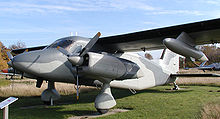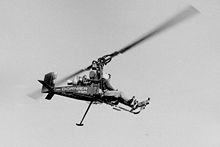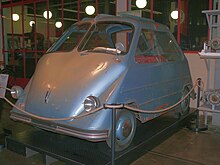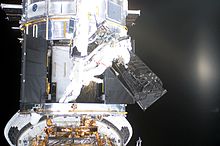Dornier Flugzeugwerke
This article needs additional citations for verification. (January 2008) |
 | |
| Company type | Privately held company |
|---|---|
| Industry | manufacture of air and spacecraft and related machinery |
| Founded | 1922 |
| Defunct | 2002 |
| Fate | Acquired by Fairchild Aircraft in 1996 |
| Successor | Airbus Group |
| Headquarters | Manzell, Friedrichshafen, Germany |
Key people | Claude Dornier |
| Parent | Daimler-Benz (from 1985) |
| Website | http://www.eads.com/ |
Dornier Flugzeugwerke was a German aircraft manufacturer founded in Friedrichshafen in 1914 by Claude Dornier. Over the course of its long lifespan, the company produced many designs for both the civil and military markets.
History
Originally Dornier Metallbau, Dornier Flugzeugwerke took over Flugzeugbau Friedrichshafen production facilities (Weingarten, Warnemünde, and the former Zeppelin shed at Manzell) when it failed in 1923. Dornier rose to prominence in the 1920s and 1930s as a manufacturer of large, all-metal flying boats, including the 1924 Wal (Template:Lang-en) and the Do X. Dornier also built a series of successful land planes, including the Komet (Comet) and Merkur (Mercury) that were used by Luft Hansa and other European carriers during the 1920s and early 30s. Dornier built its aircraft outside Germany during much of this period, in compliance with the restrictions placed on German aircraft manufacturers by the Treaty of Versailles. Foreign factories licence-building Dornier products included CMASA and Piaggio in Italy, CASA in Spain, Kawasaki in Japan, and Aviolanda in the Netherlands. Once the Nazi government came to power and abandoned the treaty's restrictions, Dornier resumed production in Germany.




Dornier's most significant military aircraft design before and during World War II was the Do 17, nicknamed The Flying Pencil. It was developed and first flown in 1934 as a commercial aircraft in competition for a Lufthansa contract. Due to its narrow fuselage (hence its nickname) it was not commercially attractive and was passed over by Lufthansa. Dornier then further developed it as a military aircraft with a prototype bomber first flying in 1935. In 1937, it was employed in pro-Fascist terror bombings by the German Condor Legion during the Spanish Civil War. Production continued within Germany and this versatile two-engined aircraft was developed by the Luftwaffe into multiple combat variations. The medium bomber variant saw much service during the early part of World War II including extensive use in the Battle of Britain. It was later developed into an effective nightfighter to defend Germany from the RAF bomber offensive. Dornier developed the successful Do 217 based on the Do 17; ostensibly looking like its younger sibling, this larger and much heavier bomber was in fact a completely new design. Dornier also developed the fastest piston-engined fighter of the war, the two-engined Do 335, introduced too late to enter combat service.
Dornier's history of successful flying boats (the "Wal" family) lead to new models that saw service in several armed forces around the world as well as Germany, including the Do 22, Do 18, and Do 24.
After WWII, aircraft production was again forbidden in Germany, and Dornier relocated to Spain and then to Switzerland where the firm provided aeronautical consultancy services until once again returning to Germany in 1954. Post-war, Dornier quickly re-established itself with highly successful small STOL transports such as the Do 27 and Do 28. Additionally, in 1974 it developed the Alpha Jet as part of a joint venture with French aircraft manufacturers Dassault-Breguet. The plane was well received and established itself as the new standard NATO trainer during the 1970s and 80s.
In 1983, Hindustan Aeronautics Limited (HAL) bought a production licence for the Dornier Do 228 and manufactured the aircraft for the Asian market sphere. By 2013 a total of 117 Dornier DO-228 aircraft had been produced by HAL with plans to build 20 more during 2013-14.[1]
In 1985, Dornier became a member of the Daimler-Benz group integrating its aeronautic assets with the parent company. As part of this transaction, Lindauer Dornier GmbH was spun off, creating a separate, family-owned firm, concentrating on textile machinery design and manufacturing. The rest of the company was split into several subsidiaries for defence, satellites, medtech and aircraft.
In 1996, the majority of Dornier Aircraft was acquired by Fairchild Aircraft, forming Fairchild Dornier. This company became insolvent in early 2002. Production of its 328 Jet was acquired by US company Avcraft. Asian groups continued to show interest in its 728 version in August 2004, but production had not restarted. The other subsidiaries became part of the EADS; the medtech division was sold to an investment company and now bears the name Dornier MedTech. Dornier Medtech manufactures medical equipment, such as the Dornier S lithotriptor, HM3, Compact Delta to treat kidney stones. Dornier MedTech also manufactures laser devices for a wide range of applications.[2]
Dornier Seaplane Company
The Dornier family have a spin-off company and project, the Dornier Seastar. It is a turboprop-powered amphibious aircraft built largely of composite materials. This was developed by Claudius Dornier Jr.
Dornier aircraft projects
Letter designations (before 1933)
(Does not include designations for aircraft built while Dornier was with Zeppelin-Lindau)
- Dornier Gs Precursor to Wal destroyed by Military Inter-Allied Commission of Control (1919)
- Dornier Do A Libelle (I 1921, III redesignated Do 12)
- Dornier Spatz Landplane version of Do A (1922)
- Dornier Do B Merkur Development of Do C (1926)
- Dornier Do C Komet (I 1921, II 1922, III 1926)
- Dornier Do C 2, 3, 4 Fighter unrelated to earlier Do C, redesignated Do 10 (C 2 ?, C 3 1931, C 4 1932)
- Dornier Do D (1929)
- Dornier Do E (1924)
- Dornier Do F (1932, redesignated Do 11, 13, 23)
- Dornier Do G Grief (Cancelled 1920 project)
- Dornier Do H Falke (1922 development of Dornier-Zeppelin D.I)
- Dornier Do I (1923 twin engine long range reconnaissance aircraft)
- Dornier Do J Wal (1922)
- Dornier Do K (K 1 1929, K 2 1929, K 3 1931)
- Dornier Do L Delphin (I 1920, II 1921, III 1927)
- Dornier Do N Design for Japanese as Kawasaki Ka 87 (1926)
- Dornier Do O Wal Custom built version of Do J (1924)
- Dornier Do P (1930)
- Dornier Do R.2 and R.4 Superwal (1924)
- Dornier Do S (1930)
- Dornier Do T (Komet/Merkur converted to Air Ambulance)
- Dornier Do U (Cancelled civil variant of Do Y)
- Dornier Do X (1929)
- Dornier Do Y (1930, redesignated Do 15)
Additional unbuilt projects include 3 different Schneider Trophy racers from 1924, 1928 and 1931 and a large multi-engine seaplane similar to the Do X with engines buried in the wings.
1933-1945
- Dornier Do 10
- Dornier Do 11
- Dornier Do 12
- Dornier Do 13
- Dornier Do 14
- Dornier Do 15
- Dornier Do 16
- Dornier Do 17
- Dornier Do 18
- Dornier Do 19
- Dornier Do 22
- Dornier Do 23
- Dornier Do 24
- Dornier Do 26
- Dornier Do 29 (1934)
- Dornier Do 212
- Dornier Do 214 Project
- Dornier Do 215
- Dornier Do 216 Project
- Dornier Do 217
- Dornier Do 247 Project
- Dornier Do 317
- Dornier Do 335
- Dornier Do 635
- Dornier P 256
1945-present
- Dornier Do 25 Prototype for Do 27
- Dornier Do 27
- Dornier Do 28 - developed from Do 27
- Dornier Do 29
- Dornier Do 31
- Dornier Do 32
- Dornier Do 128
- Dornier Do 132
- Dornier Do 228 - developed from Do 28
- Dornier Do 231
- Dassault/Dornier Alpha Jet
- Dornier 328
- Fairchild Dornier 328JET
- Fairchild Dornier 428JET
- Fairchild Dornier 728 family
- Dornier Aerodyne
- Dornier Seawings Seastar
- Dornier S-Ray 007
Dornier Automobile Projects

- Dornier Delta
- Dornier Delta II, developed for Hymer
Dornier Faint Object Camera

Dornier GmbH built the Faint Object Camera for the Hubble Space Telescope, which was used from 1990 to 2002. The ESA funded the unit, which actually consists of two complete and independent camera systems designed to provide extremely high resolution, exceeding 0.05 arcseconds. It is designed to view very faint UV light from 115 to 650 nanometers in wavelength.[3] It was the last original instrument on the Hubble when it was replaced by the Advanced Camera for Surveys in 2002.
Missile projects
Spacecraft
- AMC-5 (satellite)
- Project 621 (rocket)
See also
References
- ^ [title=http://articles.economictimes.indiatimes.com/2013-01-24/news/36527149_1_aircraft-maritime-surveillance-hal%7CURL=http://articles.economictimes.indiatimes.com/2013-01-24/news/36527149_1_aircraft-maritime-surveillance-hal]
- ^ [title=India to present Dornier aircraft to Seychelles for surveillance, anti-piracy missions|url=http://articles.economictimes.indiatimes.com/2013-01-24/news/36527149_1_aircraft-maritime-surveillance-hal]
- ^ "FOC - Faint Object Camera". Hubble. European Space Agency. 2006-12-12. Retrieved 2007-02-07.
